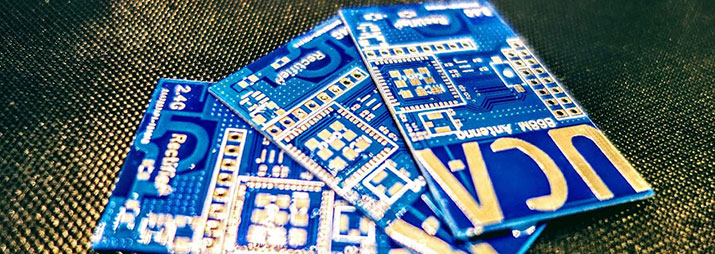Antennas for Compact IoT Devices: Challenges and Perspectives
The Internet of Things (IoT) has increased our expectations of benefit from a smart and cognitive world in the next future. We eagerly wait to effectively live in green smart cities, working in efficient smart buildings, coming back at night to our sweet smart homes, driven by a high-tech autonomous car. If this will become a reality or not depends mainly on the capacity of building a reliable massive IoT infrastructure in which billions of objects will be connected to the internet.
One of the key issues is the wireless connectivity of such objects. On the one hand, we want to connect smaller and smaller objects, such as implantable e-health devices, key-chain trackers and miniaturized environmental sensors. On the other hand, most of the wireless standards used for IoT work in sub-GHz frequency bands (e.g., 868 MHz) where long-distance propagation and building penetration are much less challenging. These two aspects make the design of antennas for IoT devices extremely challenging.
The laws of the physics tell us that a “good” antenna must have dimensions comparable to the wavelength of the signal to transmit. Classical quarter-wave monopole antennas are therefore almost 9 cm long at 868 MHz, which clearly does not allow the integration level required by modern IoT applications and devices.
Designing antenna for the IoT means therefore to design electrically small antennas. What does this mean?
As the antenna gets smaller, its performance suffers from two main effects. First, the antenna becomes less efficient. The efficiency of an antenna is defined as the ratio between the antenna radiated power and the one injected into the antenna. When the antenna is small, most of the electromagnetic energy gets trapped into the antenna structure instead of being radiated in far-field. Most importantly, the efficiency reduction is not linear with the antenna size. If the antenna becomes too small, the efficiency suddenly falls to levels that transform the antenna into a heating resistor, making it totally useless. Furthermore, IoT devices are very cost-sensitive, and antennas for IoT must be produced using cheap materials. Many of them are directly printed on dielectric substrates suitable for circuit board mass-production, such as Epoxy FR4. The higher losses introduced by these materials further worsen the efficiency drop.
The second effect of miniaturization is the reduction of the antenna operating bandwidth. This latter is defined as the frequency range in which the antenna is well matched, i.e. where there is a good transfer of energy from the source to the antenna. For antennas for compact terminals, usually, at least 75% of the energy is required to be transferred to the antenna (or equivalently, at most 25% mismatch losses are accepted). As the antenna gets smaller, the operating bandwidth becomes narrower. Given the small amount of data needed to be transmitted by IoT devices, this is not, in and of itself, a problem. The problem lies in the consequent increase of the antenna sensitivity to the close environment.
In general, the radiation behavior of an antenna is always perturbed from anything entering into his near field. In particular, what happens is that the antenna resonance shifts in frequency. This is usually not a problem, as the antenna bandwidth is larger than the bandwidth of the signal to be transmitted. Imagine the antenna as a target and the signal as an arrow. If the target is large, even if you move it a little bit while the arrow is flying, the arrow will still hit the target, even if probably not at the center. Unfortunately, this does not apply to IoT antennas that, because of miniaturization, exhibits narrow bandwidths, sometimes of few MHz. A small shift in the antenna resonance would make the antenna no more capable of transmitting the desired signal. It is like suddenly playing with a very small target.
Ok, designing small antennas for compact IoT devices can be a challenging task. Then what? Here are some perspectives:
- Miniaturization is important if it comes with efficiency. Antenna efficiency is the key parameter to care about. It is way more important than impedance matching (which is the first performance criteria for larger antennas). An antenna can be always matched to 50 Ohms whatever its dimension, but it does not mean that it will radiate. A 50 Ohm resistance has a perfect matching (over a huge bandwidth) but you do not want to use it as an antenna.
- The device and the application must be carefully considered from the beginning of the antenna design phase. The more details you know about the device (e.g., shape and material of the casing, presence of other electronic components, position of the battery, etc.) or the application (e.g., will the device be placed on the body?), the more likely it is that the antenna will efficiently work when integrated into the device.
- Measurements in real operation conditions are required. If the antenna will be integrated into a compact IoT device, directly connected to the RF transceiver, it does not make sense to measure it using big vector network analyzer cables. New measurement procedures must be developed.
- The antenna must be designed in a way that its resonant frequency can be re-tuned when practically employed. This can be done by introducing reconfigurable solutions or simply by designing antenna geometries that can be easily modified to increase or decrease their electrical length.
The unique characteristics of IoT devices and applications can give a hard time to antenna researchers and engineers. However, they also oblige them to totally rethink the antenna design problem, opening the way to innovative and disruptive solutions.

Figure 1: 868 MHz miniature antenna, shaped as Université Côte d’Azur acronym “UCA” and integrated in compact IoT terminals1.
1 For more info: https://github.com/FabienFerrero/UCA_Board
 Leonardo Lizzi is currently an Associate Professor at the University Côte d’Azur, France. He received a master’s degree in Telecommunication Engineering and the Ph.D. degree in Information and Communication Technology from the University of Trento, Italy, in 2007 and 2011, respectively. At the moment, his research focuses on reconfigurable, miniature, multi-standards antennas for Internet-of-Things applications, wearable devices, and 5G terminals. He is the coordinator of the European School of Antennas (ESoA) Ph.D. course on “Antennas and Rectennas for IoT Applications”. He is co-author of more than 110 papers in international journals and conference proceedings.
Leonardo Lizzi is currently an Associate Professor at the University Côte d’Azur, France. He received a master’s degree in Telecommunication Engineering and the Ph.D. degree in Information and Communication Technology from the University of Trento, Italy, in 2007 and 2011, respectively. At the moment, his research focuses on reconfigurable, miniature, multi-standards antennas for Internet-of-Things applications, wearable devices, and 5G terminals. He is the coordinator of the European School of Antennas (ESoA) Ph.D. course on “Antennas and Rectennas for IoT Applications”. He is co-author of more than 110 papers in international journals and conference proceedings.
 Fabien Ferrero was born in Nice, France in 1980. Since 2018, he is Professor with the Laboratory of Electronics, Antennas and Telecommunications at Université Côte d'Azur. His research concerned the design and measurement of millimetric antennas, IoT systems, and reconfigurable antennas. Since 2013, he is co-director of the CREMANT, a joint lab between UCA, CNRS, and Orange.
Fabien Ferrero was born in Nice, France in 1980. Since 2018, he is Professor with the Laboratory of Electronics, Antennas and Telecommunications at Université Côte d'Azur. His research concerned the design and measurement of millimetric antennas, IoT systems, and reconfigurable antennas. Since 2013, he is co-director of the CREMANT, a joint lab between UCA, CNRS, and Orange.
Sign Up for IoT Technical Community Updates
Calendar of Events
IEEE 8th World Forum on Internet of Things (WF-IoT) 2022
26 October-11 November 2022
Call for Papers
IEEE Internet of Things Journal
Special issue on Towards Intelligence for Space-Air-Ground Integrated Internet of Things
Submission Deadline: 1 November 2022
Special issue on Smart Blockchain for IoT Trust, Security and Privacy
Submission Deadline: 15 November 2022
Past Issues
September 2022
July 2022
March 2022
January 2022
November 2021
September 2021
July 2021
May 2021
March 2021
January 2021
November 2020
July 2020
May 2020
March 2020
January 2020
November 2019
September 2019
July 2019
May 2019
March 2019
January 2019
November 2018
September 2018
July 2018
May 2018
March 2018
January 2018
November 2017
September 2017
July 2017
May 2017
March 2017
January 2017
November 2016
September 2016
July 2016
May 2016
March 2016
January 2016
November 2015
September 2015
July 2015
May 2015
March 2015
January 2015
November 2014
September 2014


